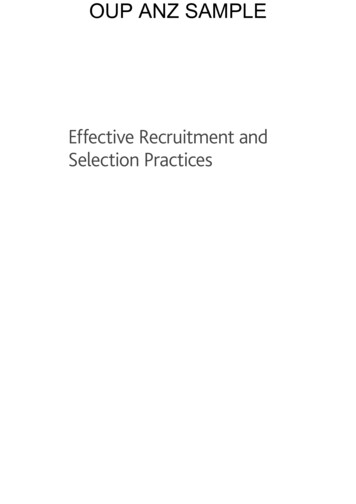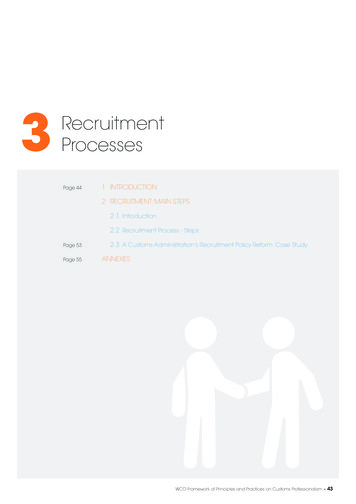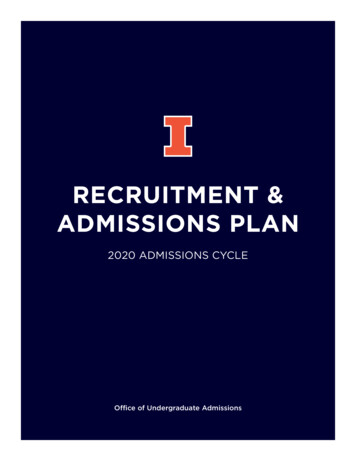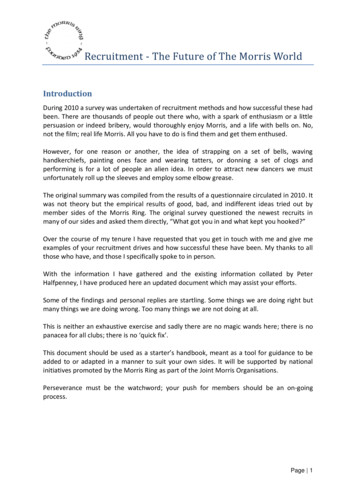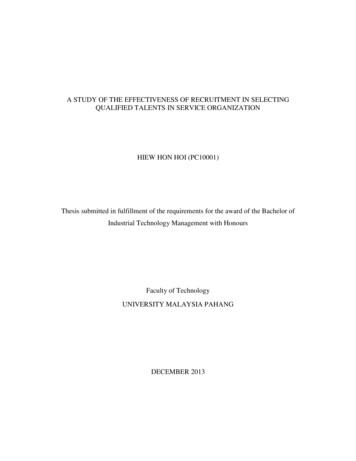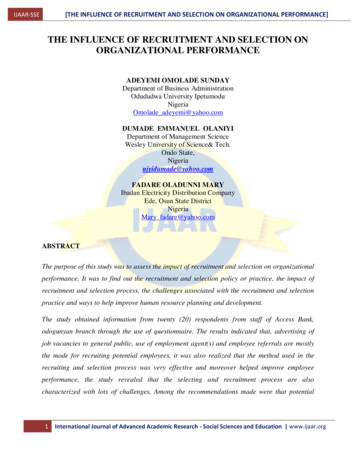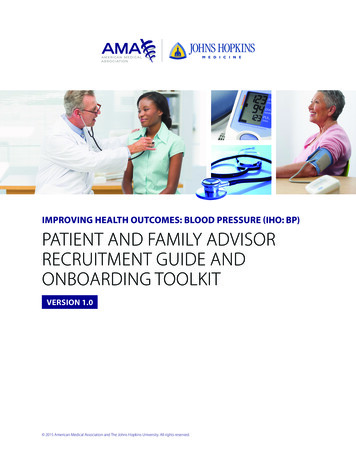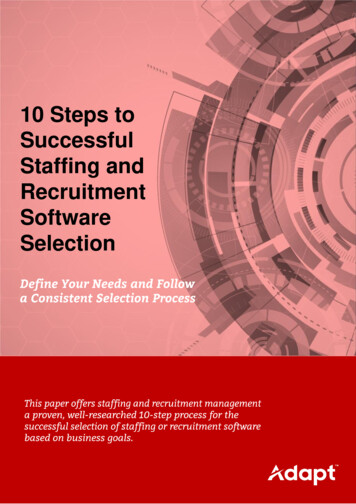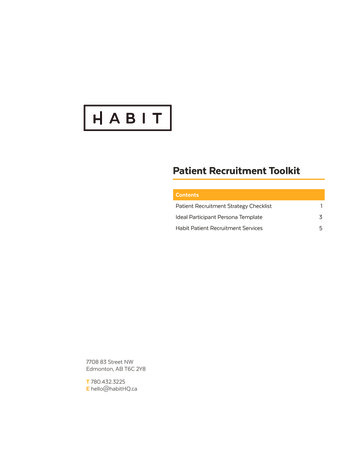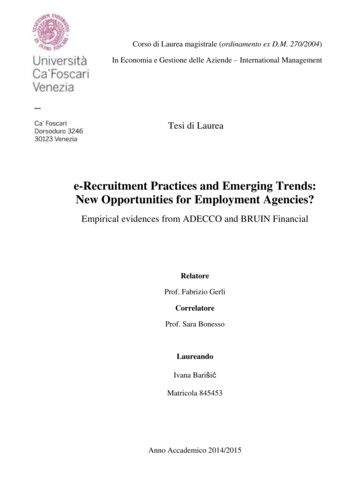
Transcription
Corso di Laurea magistrale (ordinamento ex D.M. 270/2004)In Economia e Gestione delle Aziende – International ManagementTesi di Laureae-Recruitment Practices and Emerging Trends:New Opportunities for Employment Agencies?Empirical evidences from ADECCO and BRUIN FinancialRelatoreProf. Fabrizio GerliCorrelatoreProf. Sara BonessoLaureandoIvana BarišićMatricola 845453Anno Accademico 2014/2015
AcknowledgmentThis thesis becomes a reality with the kind support and help of many individuals. Iwould like to extend my sincere thank you to all of them.Foremost, I would like to express my gratitude to my family, for all the encouragementand support throughout my student years, which helped me in completion of this paper.Mom and Dad, thank you for your amazing, inspiring parenting; for always being there,believing in me, and supporting me in every possible way. To my sister Dijana; thankyou for always showing me the bright side of things and pushing me to take on thepositive path in every situation, while motivating me to do the best I can.Next, I would like to thank BRUIN Financial for providing me with the opportunity toget a first hand insight into the topic covered by this thesis and my longtime friend, MsAna Maria Tuliak, who was always so kind to help me, either with work or with theinformation provided for the purpose of this thesis. I wish also to thank Ms. EmilyAyre; her guidance through the three months of internship at BRUIN were inspiringenough to make me consider human resource management as my probable career ofchoice. I wish also to thank Ms Martina Špiljak from Adecco Croatia, for her honest andcooperative response to all the questions solicited in this study.A special gratitude goes to my mentor, Prof. Fabrizio Gerli, for imparting hisknowledge and expertise in this study, while being very positive, considerate andsympathetic in guidance through all the phases of this thesis.Thanks to my friend Tin for all the technological help regarding the thesis. My thanksand appreciations also go to my colleagues as well as all the people who have willinglyhelped me out with their abilities.
AbstractThe purpose of this thesis was to explain the various changes occurring in the currentrecruitment environment. The new recruitment trends delivered by the constantlydeveloping technologies provide an opportunity for the employment agencies to dealwith the recruitment process in a more efficient and effective way, while reducing thecost of their activities. One of the most innovative trends with a great potential for theemployment agencies' recruitment process is the implementation of gamification. Thepurpose of this thesis was to identify the influence, presence and the perceived benefitsof the specific new recruitment trends in the cases of employment agencies. Two casestudies were conducted, each representing an employment agency’s recruitment processand use of e-recruitment sources, as well as their perceived potential of theimplementation of gamification as a potential candidate sourcing strategy. Both of thefirms are successful companies, one being a world’s leading provider of HR solutions(Adecco) and the other a leading independent recruitment consultancy in the UnitedKingdom (BRUIN). The results of the case studies should demonstrate the recentrecruitment trends’ penetration in employment agencies. The particular characteristicsof each company will be analysed as well, as they may represent an innovative exampleof recruitment strategy.This thesis will explore the literature available to date on this new but growing conceptand explore what it is that is attracting HR professionals to support their strategic impactwith gamification platforms.The methodology adopted to support this is to position the primary research data in casestudy format. The case study information was gathered from two semi structuredinterviews with representatives from global organisations currently using gamificationplatforms to support employee engagement and customer retention as their recrutimentstrategies.
Table of ContentsIntroduction . 11.RECRUITMENT . 31.1.1.1.1.The Traditional Recruitment Process . 41.1.2.Traditional Recruitment vs. e-Recruitment . 61.2.2.Traditional Recruitment . 3E-RECRUITMENT . 91.2.1.What is e-Recruitment? . 91.2.2.The e-Recruitment process . 121.2.3.The e-Recruitment sources . 131.2.4.The e-Recruitment model . 201.2.5.Major trends in the recruitment practice. 251.2.6.Legal and Ethical Issues arising from e-Recruitment. 37GAMIFICATION . 492.1.What is Gamification? . 492.2.What is a Game? . 582.2.1.Video Games . 622.2.2.Serious Games . 652.3.Game Elements . 672.3.1.2.4.Gamification as Motivational Design . 782.4.1.2.5.The PBL Triad . 71The Theories of Motivation . 78Game Design Techniques . 852.5.1.Game Thinking . 882.5.2.Activity cycles . 90
2.6.Gamification in Recruitment . 972.6.1.Describing the Trend: Introduction of Gamification into RecruitmentPractices 973.2.6.2.The targeted “Players” for Gamification for Recruitment. 1002.6.3.Gamification for solving Recruitment 2.0 Problems . 1022.6.4.Gamification for Employer Branding, Engagement and Crowdsourcing . 1052.6.5.Popular cases of introduction of Gamification for Recruitment Purposes 1092.6.6.Critical overview of the concept of Gamification . 119CASE STUDIES . 1233.1.Methodology. 1233.1.1.Research Aims and Objectives . 1233.1.2.Research Methodology . 1243.2.Adecco Group . 1293.2.1.Adecco Croatia . 1313.2.2.Adecco’s Recruitment Process . 1333.2.3.Issues related to candidate sourcing and selection . 1423.2.4.Adecco and Gamification . 1453.3.BRUIN Financial . 1533.3.1.BRUIN Financial’s Recruitment Process . 1553.3.2.Issues and solutions to the new recruitment process . 1613.3.3.Gamification in BRUIN Financial . 1633.4.Analysis of the Two Case Studies . 171Conclusion . 177Bibliography . 180
IntroductionThis thesis is a research on the change in recruitment which has been occurring in the lastdecade by constantly producing new and adapted versions of techniques which contributeto a better and more productive way of recruitment i.e. acquirement of the high qualitycandidates. The research will be aimed at the “sourcing” part of the recruitment process.The focus of this study will be solely based on the process of recruiting external candidatesperformed by the dedicated (external) recruiter by using Internet-related sources forrecruitment as well as the more innovative process of engaging audiences by leveragingthe best of loyalty programs, game design and behavioural economics - the process of“gamification”.The process of recruitment requires thorough information sharing which can be enabled byusing different sources of social networks. Some of the novel recruitment techniques arebeing introduced through gamification, which is able to change the game in recruitment byhelping to surface the best candidates quickly, extending the pre/employment testingregime to core skills and making recruitment more social (Zichermann, Linder; 2013,p.217).In the first part of the thesis, I wish to explain what I believe are the major concepts of thisstudy, i.e. the part of the recruitment process I will be mainly focusing on in the research aswell as the sourcing channels that will further on be explained through the empirical cases.It has been noticed that various sourcing recruitment channels, such as social media(Linkedin, Facebook), are being created and implemented in the companies, in addition tothe traditional ones (advertisements, employee referrals, recruitment agencies etc), due tovarious factors such as quality, cost, availability and time. The benefits and the pitfalls ofthis new system of recruitment i.e. e-recruitment (also: electronic recruitment or onlinerecruitment), will be presented based on the most important and recent literature on thattopic. This will be the focus of the first chapter of this thesis, which will aim to clearlyexplain the today’s changing environment and the major trends taking place in therecruitment practice.The second chapter of the thesis focuses on the use of an e-recruitment 4.0 source;“Gamification". The chapter explains the main concepts of gamification, what it is and1
what it is not; how games and game design can be beneficial for provoking motivation andpositive experiences to the users; and how game elements can be applied to give rise toexcellence. Motivation is also the subject of chapter 2 of this thesis. The whole concept ofgamification for business use is actually wrapped around the concept of motivation.Motivation is what drives humans towards acting in a productive and meaningful way,while being able to express themselves as individuals, which definitely produces greaterproductivity to the firms which learn how to provoke it. Gamification draws upon areassuch as psychology, design and business, and this is why this part of the thesis aims toexplain the concept with all its counterparts. The last part of the second chapter focuses onthe use of gamification for recruitment purposes. It elaborates on theoretical part providedpreviously and draws on its implications to recruitment and HR specifically, bydemonstrating some recent successful cases of gamification introduction to recruitmentpractices.The last chapter, chapter 3, elaborates on the primary research data in case study format.Two case studies have been conducted, firstly with BRUIN Financial Ltd, a recruitmentconsultancy located in London, UK; and then with Adecco Group’s subsidiary (AdeccoCroatia) in Zagreb, Croatia. The interview questions were designed in a way to reach thedetails from recruitment processes of each firm, while taking particular notice of the use ofrecruitment sources. Gamification was the topic of the second part of the interview - andthe various implications of this phenomenon to both firms have been found and areexplained in the chapter. The research methodology which precedes the case studies,thoroughly explains the research procedure, aims and objectives.The conclusion elaborates on the results of the research, while connecting the theoreticalparts to the empirical evidences. The trends are explained in a simple and holistic way, andthe conclusion serves its purpose in providing a meaningful idea of the current recruitmentindustry trends and the evolution that is pioneered by the innovative companies, such asproposed by the two case studies.The literature gathered for the first two chapters of this thesis has been extensivelycollected through the use of Business Source Complete (www.unive.it/bec) and the use ofCa’ Foscari University’s Library of Economics (BEC) resources. Internet sources, such asscientific articles and company related websites were used for the purpose of writing thetheoretical and practical parts of this thesis as well.2
1. RECRUITMENT1.1. Traditional RecruitmentThe traditional, i.e. paper-based, recruitment of external candidates from job advertising isa linear process with consecutive tasks. It usually starts with the identification of requiredapplicants, their location and placement in the labour market, and proceeds with activitiesdesigned to attract and persuade qualified applicants to apply. Job applications are thenreceived, screened, and sorted, leading to the drawing up of a shortlist. The process endswith communicating the pre-screening results to applicants. (Anna B. Holm, 2012) Figure1. demonstrates the traditional recruitment process tasks.3
1.1.1.The Traditional Recruitment ProcessFigure 1. Traditional paper-based recruitment process using job advertisings,Source: Anna B. Holm (2012)The figure summarises the traditional process of recruiting external candidates without theuse of electronic methods. The process consists of a number of common tasks and subtasksand related activities, performed sequentially to fulfil a recruitment objective (Anna B.Holm, 2012).The sources used by companies to attract applicants in the traditional recruitment processinclude the following: newspapers, recruitment agencies, referrals from employees,suppliers, or customers, and university invitations. Today, there is also the introduction ofonline sources, such as: job boards, online recruitment sites, and SNSs that act as an4
alternative option (Gitmore & Williams, 2013; cited in Melanthiou, Pavlou &Constantinou, 2015).Traditional paper-based recruitment by means of job advertising, as shown in Figure 1, isoften viewed as a discrete, fixed process (Halperin, K. 2009, cited in Anna B. Holm, 2010),initialised by an apparent need and request for new employees. It consists of tasks andsubtasks which are fairly well-defined and repeated for each new vacancy, but which aresequential and not easily divisible. Such process design is viewed by organisational designresearchers as being complicated, since it requires the coordination of connected processesand continuous attention (Burton, DeSanctis, Obel, 2006).As Anna B. Holm (2012) further described in her study, the summary of this type ofrecruitment by task, subtask and activities can be defined as a set of logically related tasksperformed to achieve a defined business outcome for internal or external recipients. AnnaB. Holm (as presented in Figure 1), identifies the following tasks as those used in theprocess of traditional recruitment: Identification of applicants Attraction of applicants Processing of the incoming applications Communicating with the applicantsAccording to Coronas T. T. and Oliva M. A. (2005, p. 88) the process of traditionalrecruitment consists of iterative concepts such as: Submission of job request and its approval, Recognition of recruitment needs, Applications or resume screening, Job posting, Job applications submission, Pre-employment screening,5
Interviewing and employment contract and job offers.These iterative concepts are referred to as “subtasks” of the traditional process ofrecruitment by Anna B. Holm, which can be seen from Figure 1.1.1.2.Traditional Recruitment vs. e-RecruitmentRecruitment is the initial human resources function that plays a pivotal role in theorganisational success to achieve the desired objectives (Ghadeer, 2014). The traditionalrecruitment approach is paper based, followed by interviews at some geographicallocations (Nel et al., 2011; Rudman, 2010). This process is time-consuming and involves ahigh level of preparation, sometimes entailing travelling and interviewing. E-recruitment,however, refers to the practices of advertising companies’ vacancies online (Galanaki,2002), and it’s one of the well - recognised worldwide trends of the human resourcesfunctions.In the traditional form of recruitment, both the recruiters and hiring managers depend onconventional delivery mechanisms and hard copy documents to finish the process ofrecruiting. Conventional recruitment process adapts a step by step consequent process inwhich one phase initiates a set of activities only after the previous phase is completed (Lee,2005). This kind of set of related tasks can be very time consuming. Conversely, onlinerecruitment is a continuous process. In online recruitment, all processes takes placeconcurrently, which may make it a more efficient strategy compared to the traditional one.Labor intensive components of hiring like pencil and paper tests, job previews andinterviews are used vastly in traditional recruiting. The traditional process has been fraughtwith delays of mis-communications and activities which as a consequence resulted in ahigh cost of hiring.Based on the negative results from the mentioned studies, it is clear that new processes areneeded in order to lower the costs, accelerate transactions, improve efficiency, and providebetter service.According to Anna B. Holm (2012), the main changes in the recruitment process designusing e-recruiting compared to the traditional paper-based recruitment process is in thesequence of the process tasks. The technology used enables communication with currentapplicants to start simultaneously with the posting of job ads, and to be continued6
throughout the entire recruitment process. Unlike in the traditional recruitment process, thetask of communicating with applicants and processing incoming applications is performedsimultaneously with the task of attracting applicants, suggesting a major change in therecruitment process design. Apart from the apparent change in timing, the subtask ofinforming applicants about the pre-screening results is transformed into that of informingthem about the progress of their applications. Furthermore, the subtask of pre-screeningincoming applications is often initiated shortly after job advertisements were posted online.In this way, the task of communicating with candidates becomes one of the focal tasks,because it “binds” several tasks and subtasks in the process and is performed practicallythroughout the entire recruitment process. These changes are illustrated in Figure 2.Figure 2. The design and sequence of tasks in traditional paper-based recruitment process vs.the (new) recruitment process using e-recruitment, Source: Anna B. Holm (2012)Compared with the traditional recruitment process, the tasks and subtasks of therecruitment process using e-recruitment are less sequential and can be performedconcurrently. In the new process, the task of communicating with applicants commences7
during the early stages of the recruitment process, and binds the more traditional tasks withthe new task of maintaining the corporate career website.The traditional system of recruitment, compared to the new system (electronic recruitment)is:1. Time consuming (step-by-step consequent process)2. Results in a high cost of hiring (delays of mis-communication, as a consequence of thesequential process which allows this phase of the process to initiate only after theprevious phase is completed).The e-recruitment design has a major advantage over the traditional recruitment design inits task divisibility, inasmuch as problems encountered in performing one task do notnecessarily prevent progress in other tasks. It therefore requires less coordination, and ismore efficient. The move from complicated to more orderly1 (Burton, DeSanctis & Obel,2006) task design would consequently lead to a reduced administrative burden and lesscoordination of the recruitment process. Therefore;“e-recruitment is viewed and defined as the organisation of recruitment process andactivities, which, by means of technology and human agents, facilitate time-and spaceindependent collaboration and interaction in order to identify, attract, and influencecompetent candidates” (Holm, 2012, p. 91).However, some argue that the disadvantages of the e-recruitment design might come fromthe impersonalisation that comes with the introduction of a computerised system ofcommunication with the applicants. The People Management article (Carly Chenoweth,2014) points out that the dehumanisation of the recruitment process is the key pitfall of thee-recruitment system. It has become a routine to send automated messages of decline to thejob applicants, or worse of all, not to respond to unsuccessful candidates at all (CarlyChenoweth, 2014). Not doing so can be damaging to the employer brand, as it is pointedout in the People Management article (Chenoweth, 2014), because candidates are likely to1The orderly design has a major advantage over the complicated design in its taskdivisibility, inasmuch as problems encountered in performing one task do not necessarilyprevent progress in other tasks. It therefore requires less coordination, and is moreefficient (Burton, 2006)8
be customers as well. Ideally, unsuccessful applicants would receive an email that tellsthem not just that they haven’t got the role, but where they did not meet the requiredstandard.It can be concluded that the increased use of Internet related sources in recruitment couldprovide a fundamental impact on all aspects of an organisation’s recruitment function,including people, processes, organisational structures, and forms. These new processes areneeded to lower costs, accelerate transactions, improve efficiency, and provide betterservice, which present a non doubly comparative advantage vis a vis the traditional form ofrecruitment.The next few chapters of this thesis will aim to provide information based of differentstudies conducted on the topic of e-recruitment and it’s benefits compared to the traditionalform of recruiting, but also the disadvantages of the new system which might need to beconsidered when implementing the e-recruitment practices. The different e-recruitmentsources and techniques will be explored as well, together with their supposed frequency ofusage by the recruitment agencies or and HR departments.1.2. E-RECRUITMENT1.2.1.What is e-Recruitment?In order to define e-Recruiting properly, one may first need to define recruiting in general,although as mentioned earlier, e-Recruiting is not simply recruiting using electronic means(Parry and Tyson 2008). Recruitment „includes those practices and activities carried out bythe organisation with the primary purpose of identifying and attracting potentialemployees‟ (Breaugh and Starke 2000). Galanaki (2002) proposes an overview of the mostcommon ways to use the Internet as a means to recruit and identify other online activitieswithin the scope of e-Recruiting. The most common means have been described asthreefold: (1) adding recruiting pages to an existing organization site, (2) using websitesspecialized in recruiting, and (3) using electronic advertisements on media sites. Activitiesthat fall within the scope of e-Recruiting (for Galanaki) are remote interviews andassessments, smart agents to search the Internet and interactive tools (Galanaki 2002).9
Wolfswinkel, Joost and Furtmüller, Elfi and Wilderom, Celeste (2010) proposed thefollowing definition:e-Recruiting is the online attraction and identification of potential employees usingcorporate or commercial recruiting websites, electronic advertisements on other websites,or an arbitrary combination of these channels including optional methods such as remoteinterviews and assessments, smart online search agents or interactive communication toolsbetween recruiter and applicant.The terms e-recruitment, online recruitment, or internet recruiting are synonymous.(Ghadeer Mohamed Badr ElDin Aboul-Ela, 2014)The term e-recruitment has initially been defined by Heery and Noon, 2001 (cited in AnnaB.Holm, 2012) as being recruitment of candidates on the Internet.Lee (2005), who has studied the evolution of e-recruitment systems and analysed thecorporate career websites of Fortune 100 companies, emphasises that e-recruitment hasfundamentally changed the corporate recruiting process from batch mode to continuousmode, suggesting a major change in the business process. Unlike the traditional paperbased recruiting process, e-recruitment allows around-the-clock collection and processingof job applications. Thus, according to Lee (ibid.), a modern e-recruitment process is atwo-way communication process, web-enabled, time-and-space independent, and aubiquitous system for both job seekers and recruiters.Anna B. Holm (2012, p. 91) further defines it as the organisation of recruitment processand activities, which, by means of technology and human agents, facilitate time-and-spaceindependent collaboration and interaction in order to identify, attract, and influencecompetent candidates.Minton-Eversole (2007) explains, e-recruitment is a fast-growing method of hiringemployees as more and more individuals post their resumes online in search for a betterfuture. The success of e-recruitment mainly derives from the fact that now companies havethe ability to reach a larger potential applicant pool, since the geographical constrains arenon-existent (Cappelli, 2001), and individuals are more willing to travel overseas foremployment. (Melanthiou, Pavlou & Constantinou, 2015).10
With the evolution of enterprise information systems and techniques deployed and used forrecruitment purposes (Lee, 2005), e-recruitment has been further elaborated to includecandidate management technology (Parry & Tyson, 2009) and the recruitment process ingeneral, e.g. tracking applicants, selecting, offering jobs, or rejecting (Armstromg, 2006, p.420). These definitions suggest a duality of the term e-recruitment, which may besimultaneously perceived as the use of an Internet-based recruitment source and astechnology-enabled recruitment management practices.The crucial and the vital value of an organisation lies in the experience, skills,innovativeness and intellectual capital of its human resources. Today’s notion is that a lifewithout internet is an isolated life. The internet plays a major role in changing everythingaround. The last three decades witnessed significant changes in the recruitment process, thelabour market structures and the adjustment mechanisms. With the increased usage ofinternet as the latest tool used in hiring, organisations use websites as a key tool to generatea number of applicants and to provide adequate information to job applicants about theavailable jobs. The efficient use of e- recruitment will directly lead to a drastic change inthe traditional recruitment process as a whole (Parry et al., 2008).The term e-Recruitment has today been broadened with its synonyms e-Recruitment 1.0and e-Recruitment 2.0. E-Recruitment 1.0 is a product of Web 1.0 and e-Recruitment 2.0derived from today’s more developed technology, addressed as Web 2.0. The term Web2.0 was coined in 1999 to describe web sites that use technology beyond the static pages ofearlier web sites. A Web 2.0 site allows users to interact and collaborate with each other ina social media dialogue as creators of user-generated content in a virtual community, incontrast to websites (Web 1.0) where people are limited to the passive viewing of content(Broughton A., Foley B., Ledermaier S., Cox A., 2013). The e-recruitment sourcesderiving from both technologies, as well as their influence and usability in the newrecruitment process will be described in the following pages.11
1.2.2.The e-Recruitment processIn his study on Internet recruiting, Cappelli (2001) examines different service providers,new technologies, and companies’ recruitment strategies. In his view, the e- recruitmentprocess consists of three major steps: attracting, sorting, and contacting candidates. Thefirst step involves the appropriate design of web pages, using electronic networks forpromotion, a
Corso di Laurea magistrale (ordinamento ex D.M. 270/2004) In Economia e Gestione delle Aziende - International Management Tesi di Laurea e-Recruitment Practices and Emerging Trends:
